![]()
![]()
![]()
Use LEFT and RIGHT arrow keys to navigate between flashcards;
Use UP and DOWN arrow keys to flip the card;
H to show hint;
A reads text to speech;
17 Cards in this Set
- Front
- Back
|
Beowulf |
Beowulf (/ˈbeɪoʊwʊlf, ˈbiːoʊ-/;[2] Old English: [ˈbeːo̯ˌwulf]) is an Old English epic poem consisting of 3182 alliterative lines. It is the oldest surviving long poem in Old English and is commonly cited as one of the most important works of Old English literature.[3] It was written in England sometime between the 8th[4][5] and the early 11th century.[6] The author was an anonymous Anglo-Saxon poet, referred to by scholars as the "Beowulf poet".[7] |
|
|
Middle Ages |
the period of European history from the fall of the Roman Empire in the West (5th century) to the fall of Constantinople |
|
|
Sutton Hoo |
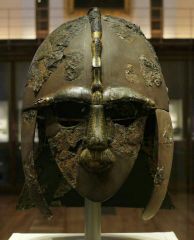
Sutton Hoo, near Woodbridge, East Anglia, is the site of two 6th- and early 7th-century cemeteries. One contained an undisturbed ship burial, including a wealth of Anglo-Saxon artefacts of outstanding art-historical and archaeological significance, most of which are now in the British Museum in London. The site is in the care of the National Trust. |
|
|
cloisonné |
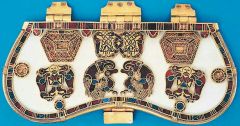
Metal brackets for purse |
|
|
Carpet pages |
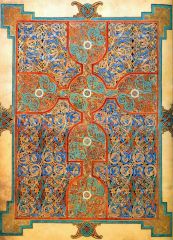
Carpet pages are a characteristic feature of Insular illuminated manuscripts. They are pages of mainly geometrical ornamentation, which may include repeated animal forms, typically placed at the beginning of each of the four Gospels in Gospel Books. The designation "carpet page" is used to describe those pages in Christian, Islamic, or Jewish illuminated manuscripts that contain little or no text and which are filled entirely with decorative motifs.[1][2][3] They are distinct from pages devoted to highly decorated historiated initials, though the style of decoration may be very similar.[4] |
|
|
Lindisfarne Gospels |
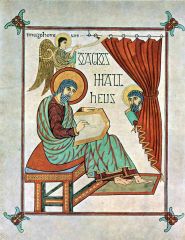
The Lindisfarne Gospels (London, British Library Cotton MS Nero D.IV) is an illuminated manuscript gospel book produced around the year 700 in a monastery off the coast of Northumberland at Lindisfarne and which is now on display in the British Library in London. The manuscript is one of the finest works in the unique style of Hiberno-Saxon or Insular art, combining Mediterranean, Anglo-Saxon and Celtic elements.[1] |
|
|
Scriptorium |
Scriptorium,[nb 1] literally "a place for writing", is commonly used to refer to a room in medieval European monasteries devoted to the writing, copying and illuminating of manuscripts by monastic scribes. Written accounts, surviving buildings, and archaeological excavations all show, however, that contrary to popular belief such rooms rarely existed: most monastic writing was done in cubicle-like recesses in the cloister, or in the monks' own cells (Schwakhofer, Melinda. "Scriptorium." Inspiraculum. 30 July 2012.). References in modern scholarly writings to 'scriptoria' more usually refer to the collective written output of a monastery, rather than to a physical room. |
|
|
illuminated manuscript |
An illuminated manuscript is a manuscript in which the text is supplemented with such decoration as initials, borders (marginalia) and miniature illustrations. In the strictest definition, the term refers only to manuscripts decorated with gold or silver; but in both common usage and modern scholarship, the term refers to any decorated or illustrated manuscript from Western traditions. Comparable Far Eastern and Mesoamerican works are described as painted. Islamic manuscripts may be referred to as illuminated, illustrated or painted, though using essentially the same techniques as Western works. This article covers the technical, social and economic history of the subject; for an art-historical account, see miniature. |
|
|
Hiberno-Saxon |
Irish became christian Insular art, also known as Hiberno-Saxon art, is the style of art produced in the post-Roman history of the British Isles. The term derives from insula, the Latin term for "island"; in this period Great Britain and Ireland shared a largely common style different from that of the rest of Europe. Art historians usually group insular art as part of the Migration Period art movement as well as Early Medieval Western art, and it is the combination of these two traditions that gives the style its special character.[2] |
|
|
chi-rho-iota |
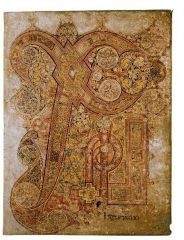
The Chi Rho (/ˈkaɪ ˈroʊ/) is one of the earliest forms of christogram, and is used by some Christians. It is formed by superimposing the first two (capital) letters chi and rho (ΧΡ) of the Greek word "ΧΡΙΣΤΟΣ" = KRistos = Christ in such a way to produce the monogram.[1] Although not technically a Christian cross, the Chi-Rho invokes the authority of Jesus, as well as symbolising his status as the Christ.[2] |
|
|
Four Evangelists |
In Christian tradition, the Four Evangelists are Matthew, Mark, Luke, and John, the authors attributed with the creation of the four Gospel accounts in the New Testament that bear the following titles: Gospel according to Matthew; Gospel according to Mark; Gospel according to Luke and Gospel according to John. |
|
|
Monastary |
Self contai ed places where monks could c onduct with their daily life A monastery is a building or complex of buildings comprising the domestic quarters and workplaces of monastics, monks or nuns, whether living in communities or alone (hermits). A monastery generally includes a place reserved for prayer which may be a chapel, church or temple, and may also serve as an oratory. |
|
|
Charlemagne |
Successor of Constantine Copied idea of sam vitale to build palatine chapel |
|
|
Carolingian |
The Carolingian Renaissance, the first of three medieval renaissances, was a period of cultural activity in the Carolingian Empire occurring from the late eighth century to the ninth century, taking inspiration from the Christian Roman Empire of the fourth century. During this period there was an increase of literature, writing, the arts, architecture, jurisprudence, liturgical reforms, and scriptural studies. |
|
|
Carolingian |
The Carolingian Renaissance, the first of three medieval renaissances, was a period of cultural activity in the Carolingian Empire occurring from the late eighth century to the ninth century, taking inspiration from the Christian Roman Empire of the fourth century. During this period there was an increase of literature, writing, the arts, architecture, jurisprudence, liturgical reforms, and scriptural studies. |
|
|
Ottonian |
Ottonian art is a style in pre-romanesque German art, covering also some works from the Low Countries, northern Italy and eastern France. It was named by the art historian Hubert Janitschek after the Ottonian dynasty which ruled Germany and northern Italy between 919 and 1024 under the kings Henry I, Otto I, Otto II, Otto III and Henry II.[1] With Ottonian architecture, it is a key component of the Ottonian Renaissance (circa 951–1024). However, the style neither began nor ended to neatly coincide with the rule of the dynasty. It emerged some decades into their rule and persisted past the Ottonian emperors into the reigns of the early Salian dynasty, which lacks an artistic "style label" of its own.[2] In the traditional scheme of art history, Ottonian art follows Carolingian art and precedes Romanesque art, though the transitions at both ends of the period are gradual rather than sudden. Like the former and unlike the latter, it was very largely a style restricted to a few of the small cities of the period, and important monasteries, as well as the court circles of the emperor and his leading vassals. |
|
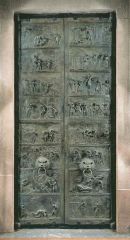
Bishop Bernward |
The Bernward Doors (German: Bernwardstür) are the two leaves of a pair of Ottonian or Romanesque bronze doors, made c. 1015 for Hildesheim Cathedral in Germany. They were commissioned by Bishop Bernward of Hildesheim (938–1022). The doors show relief images from the Bible, scenes from the Book of Genesis on the left door and from the life of Jesus on the right door. They are considered a masterpiece of Ottonian art, and feature the oldest known monumental image cycle in German sculpture, and also the oldest cycle of images cast in metal in Germany.[1] |

